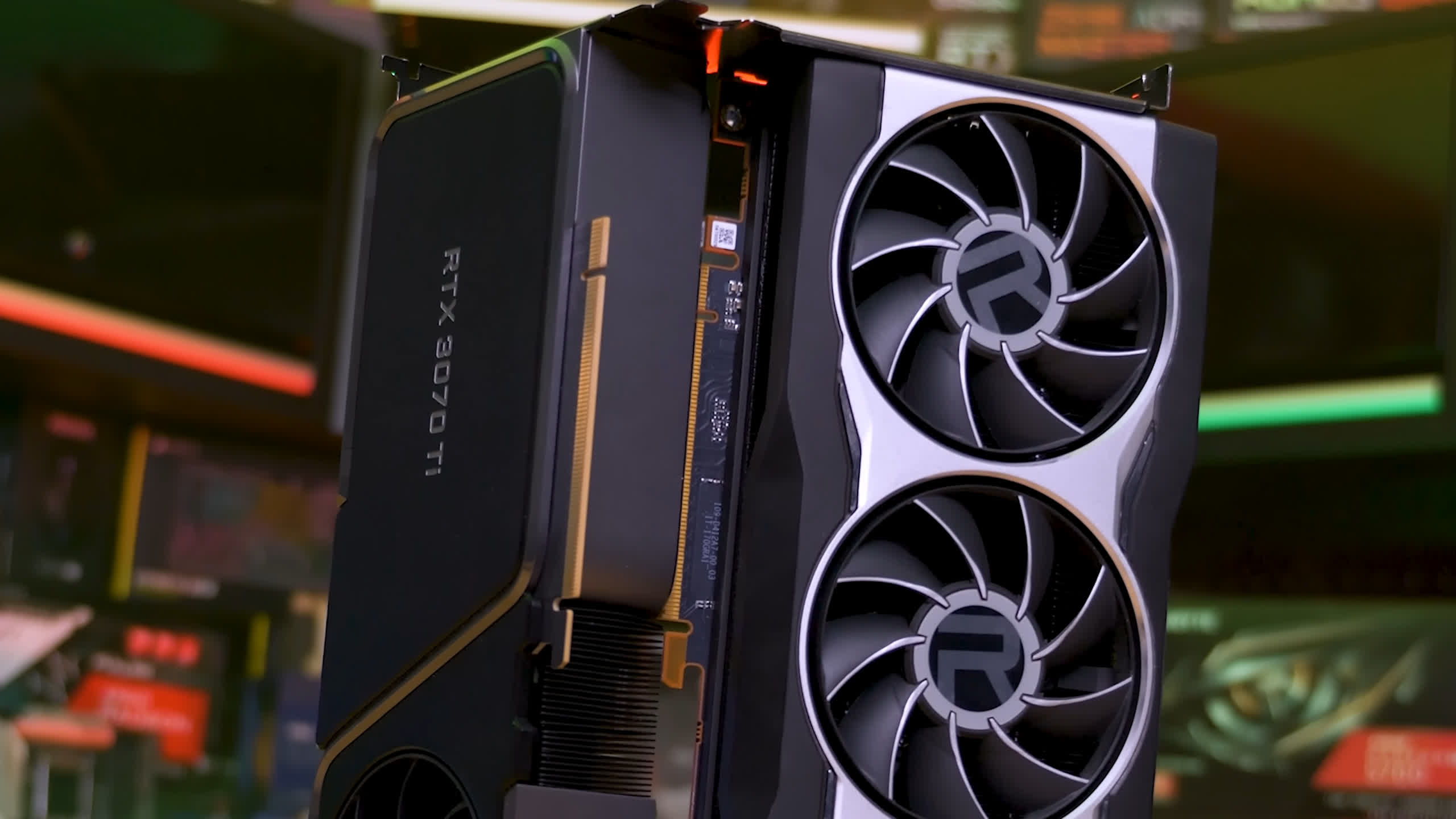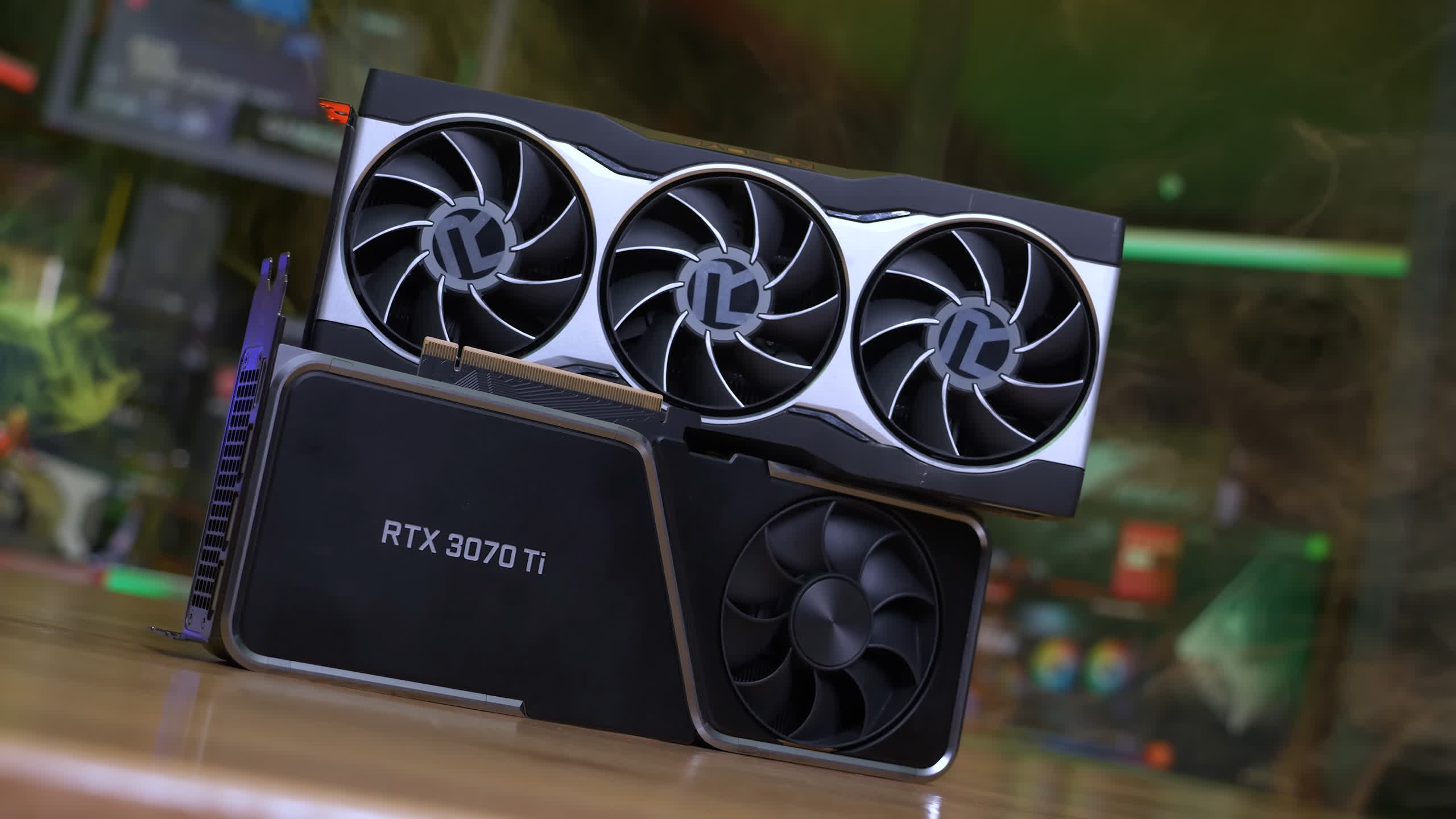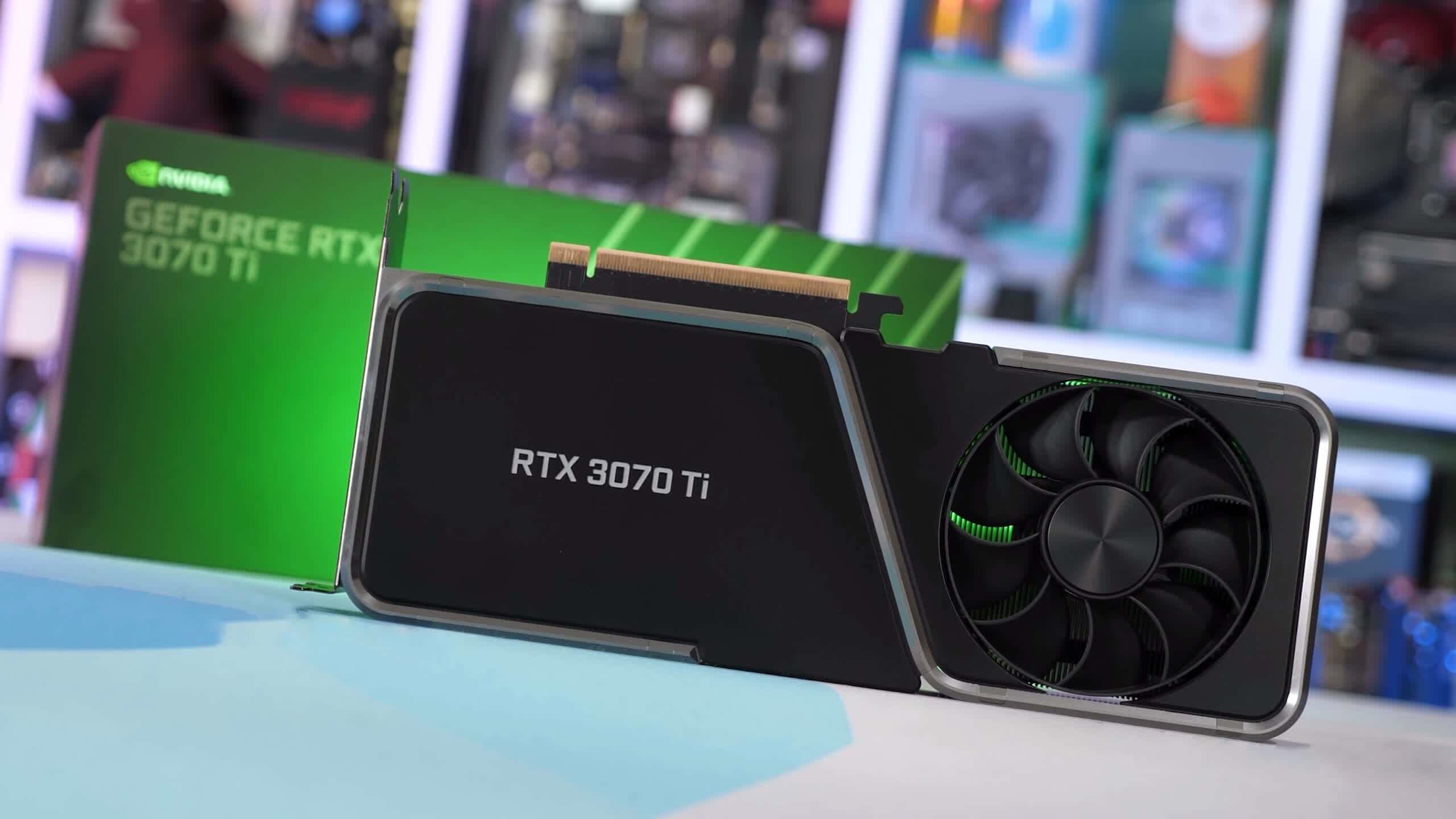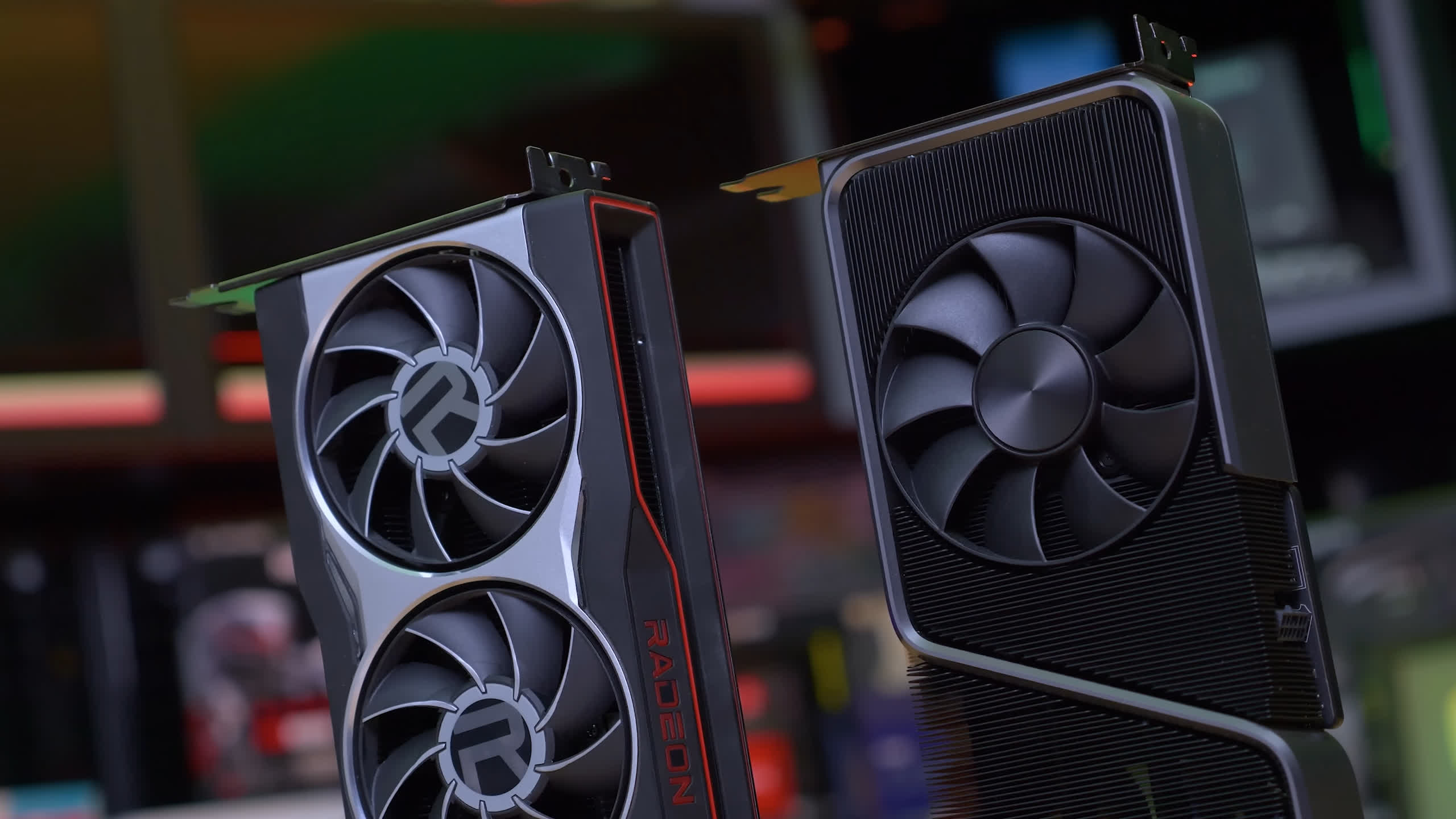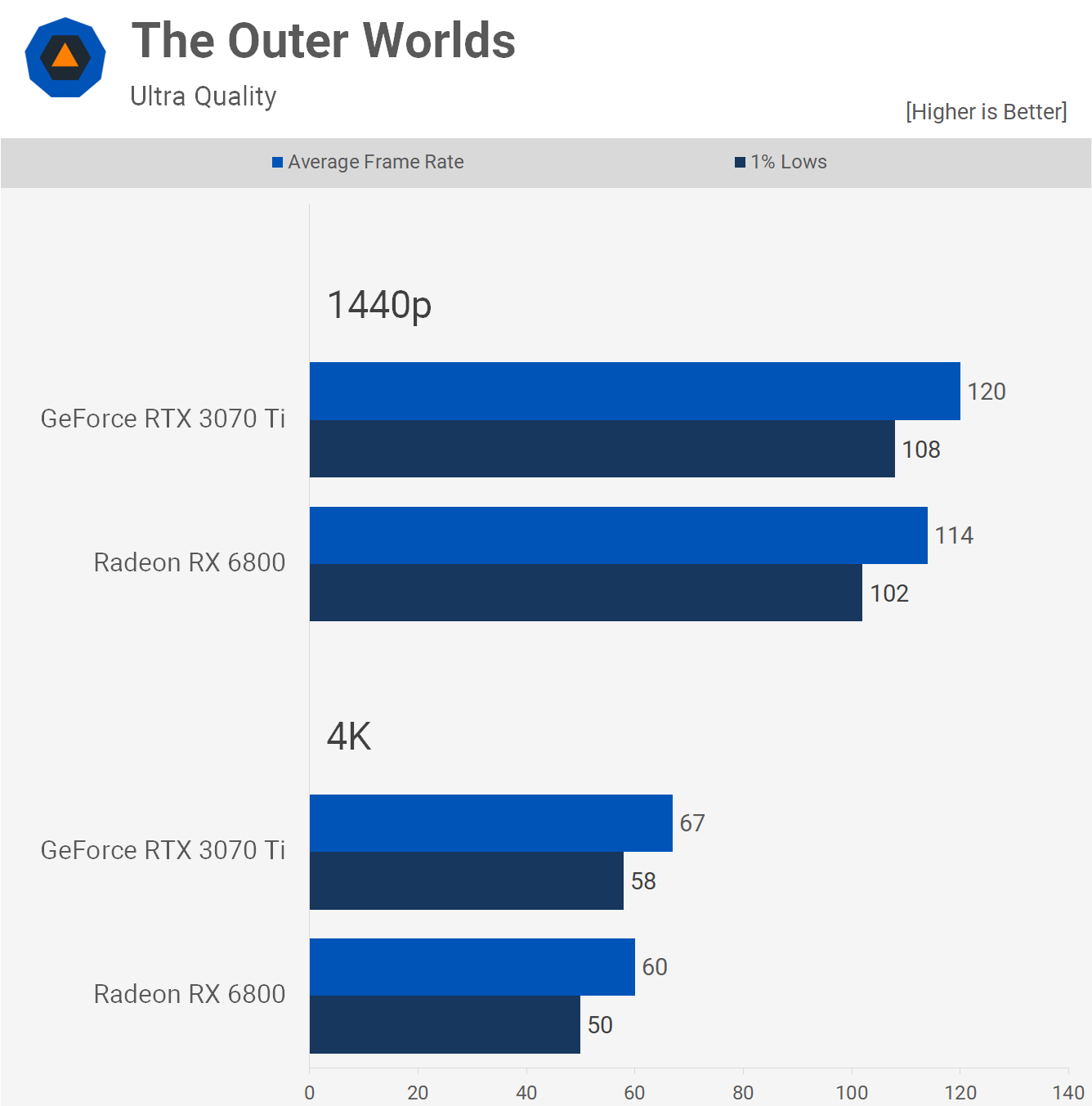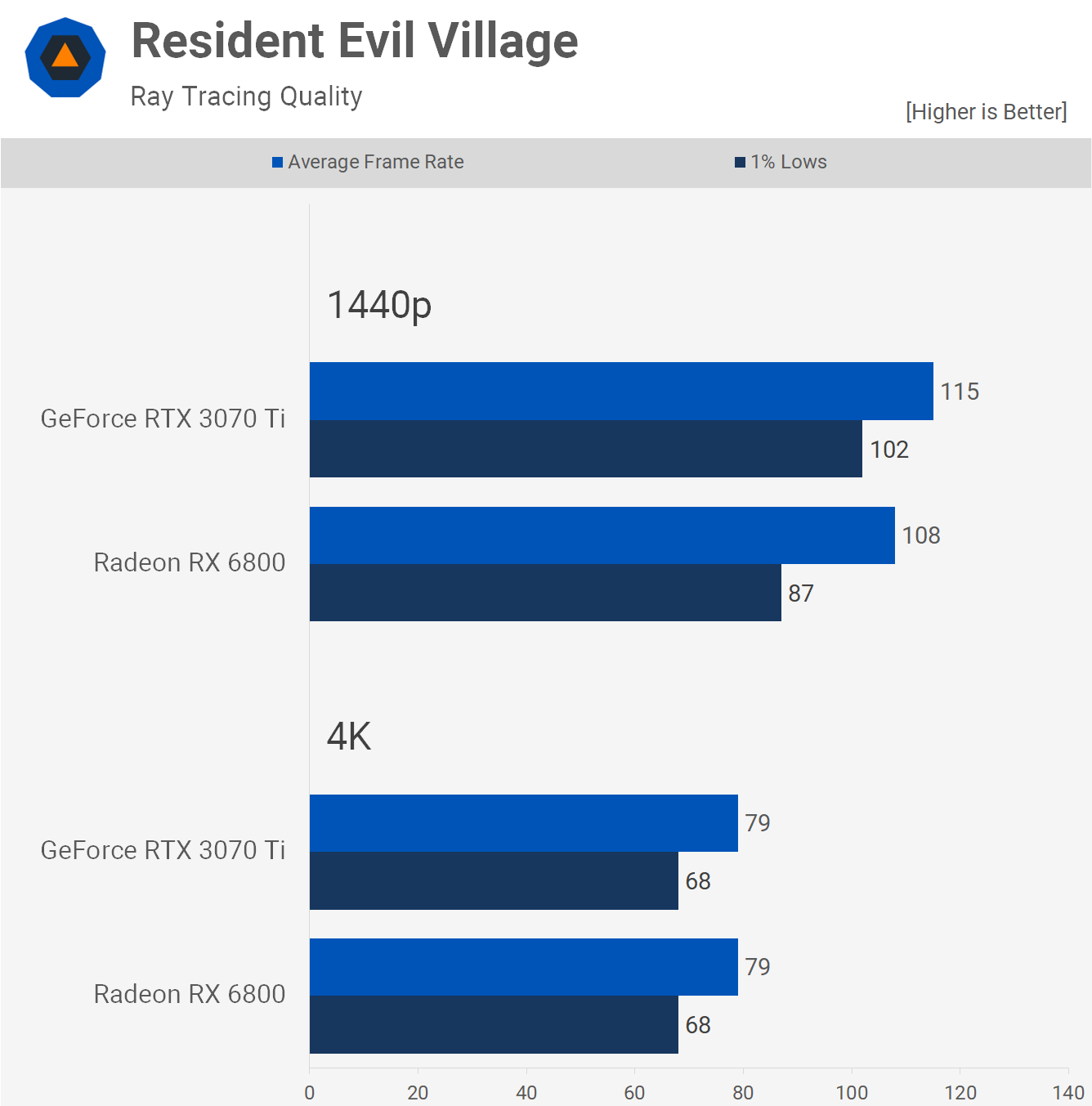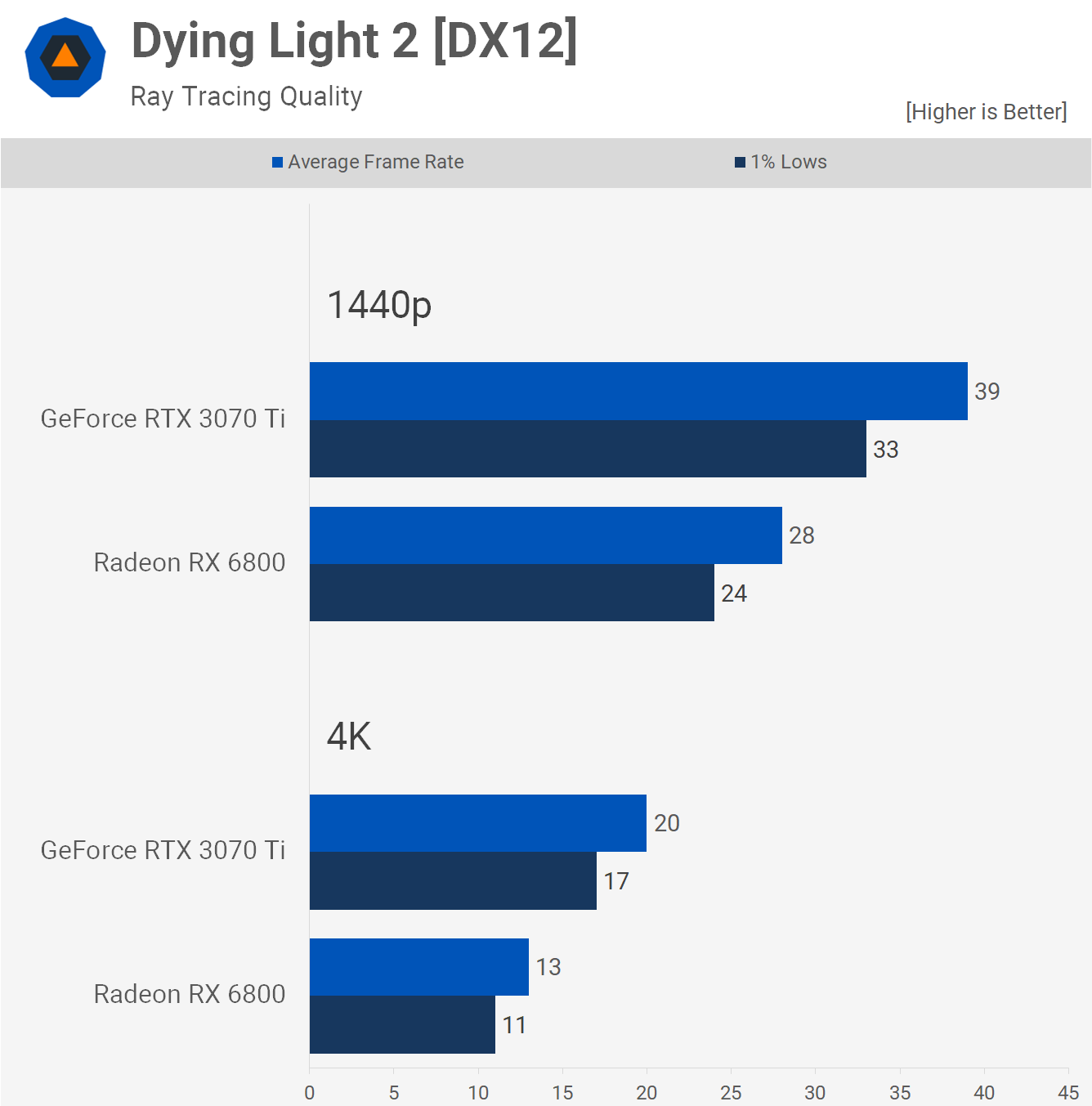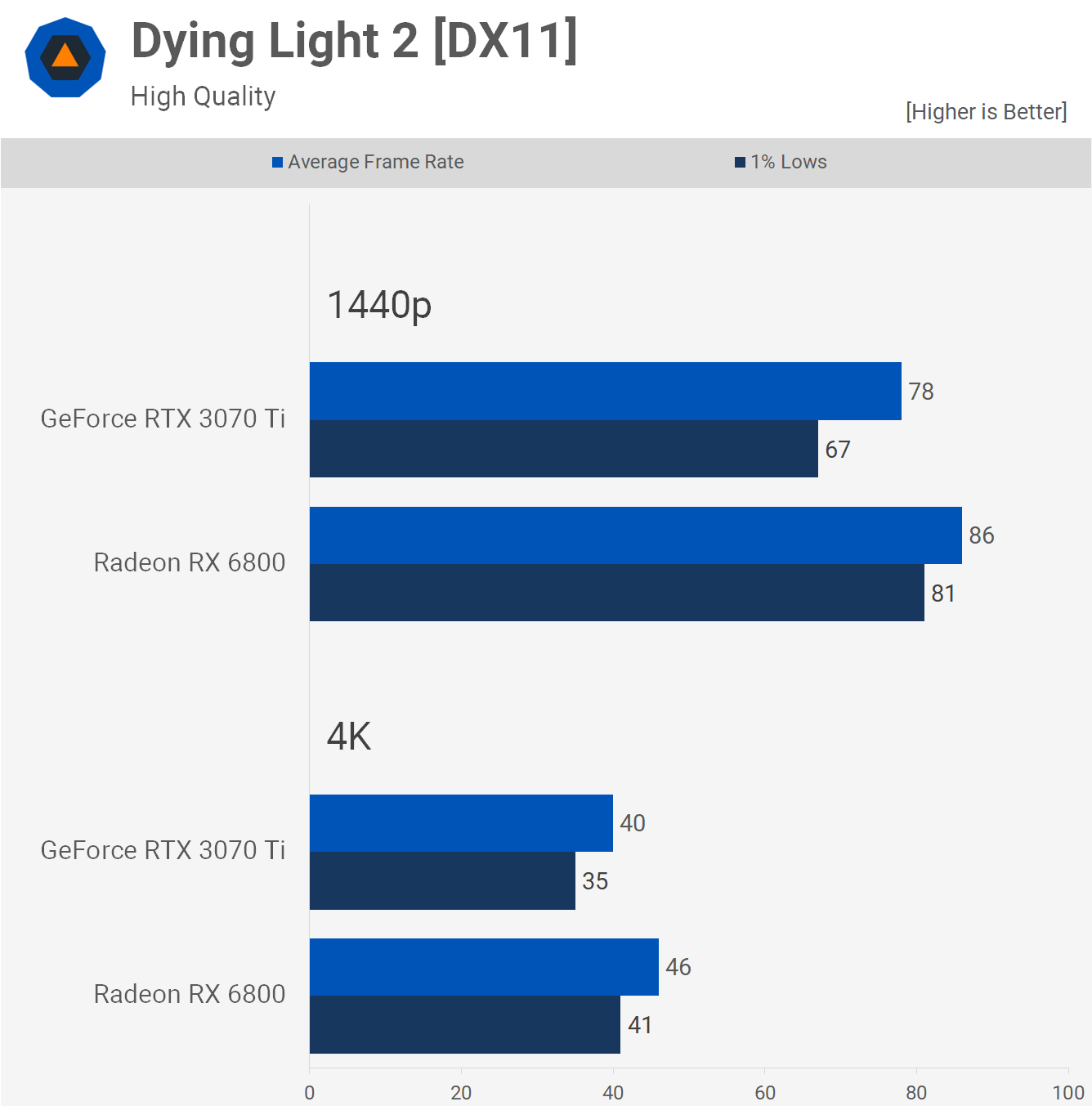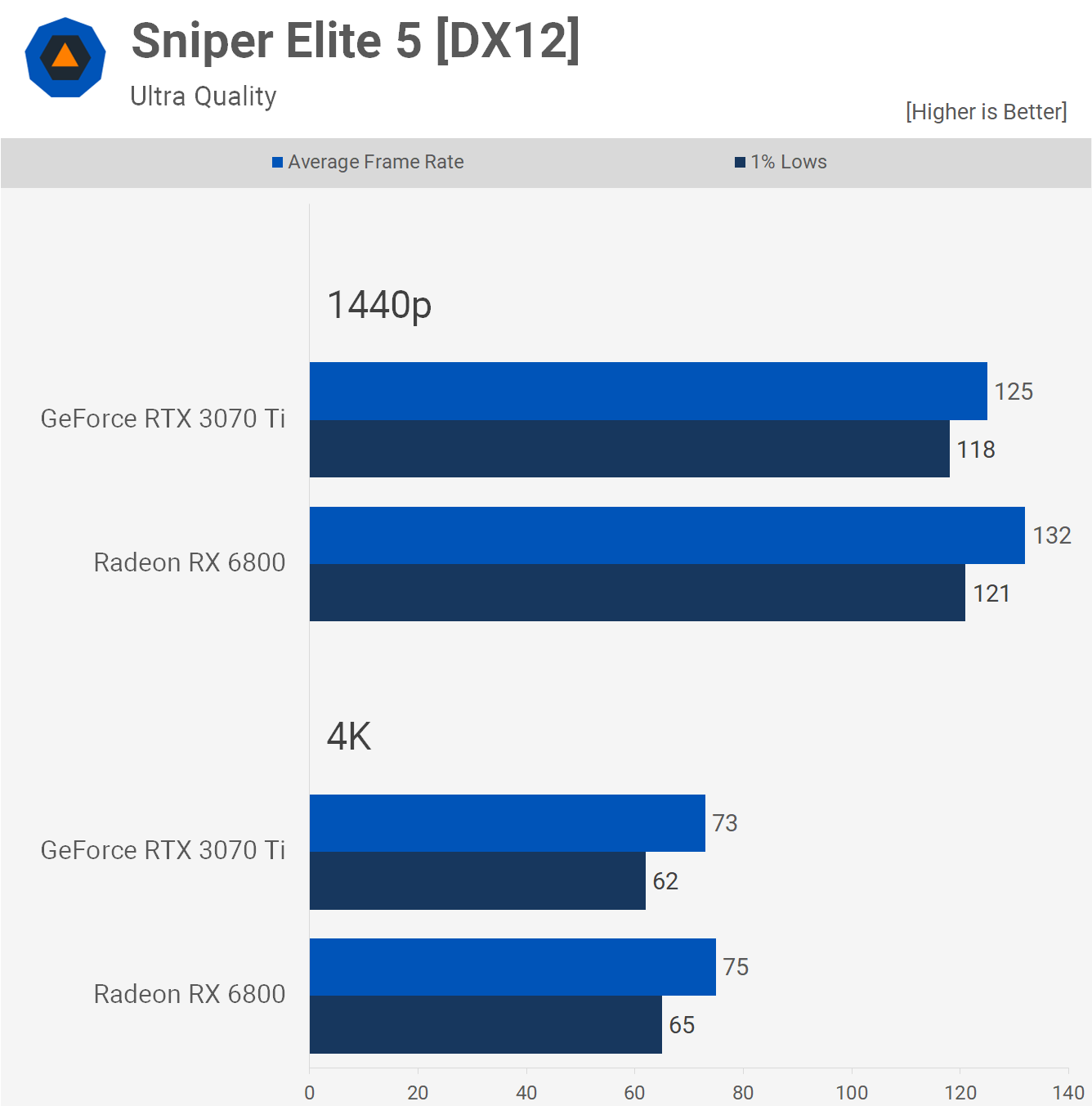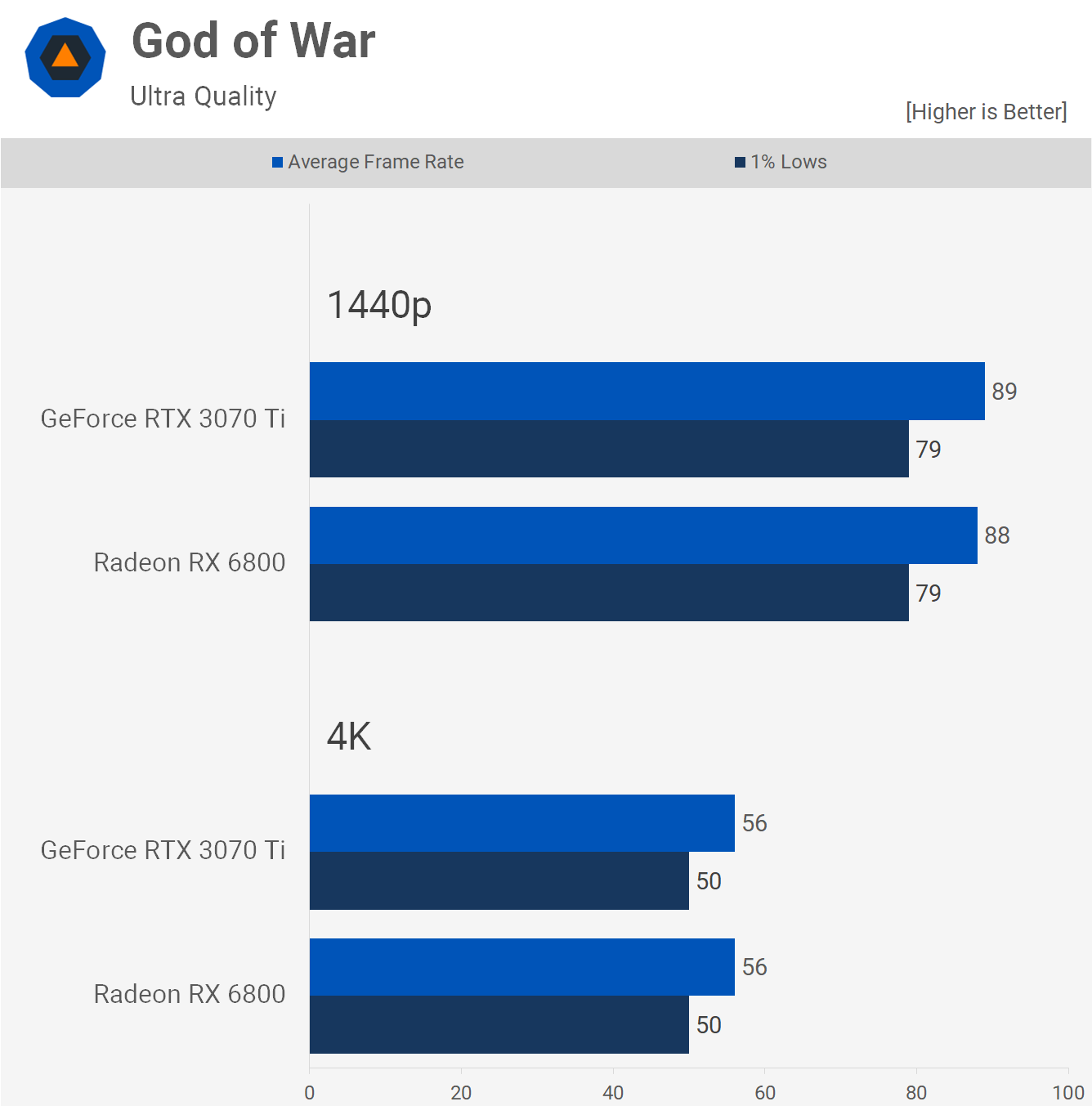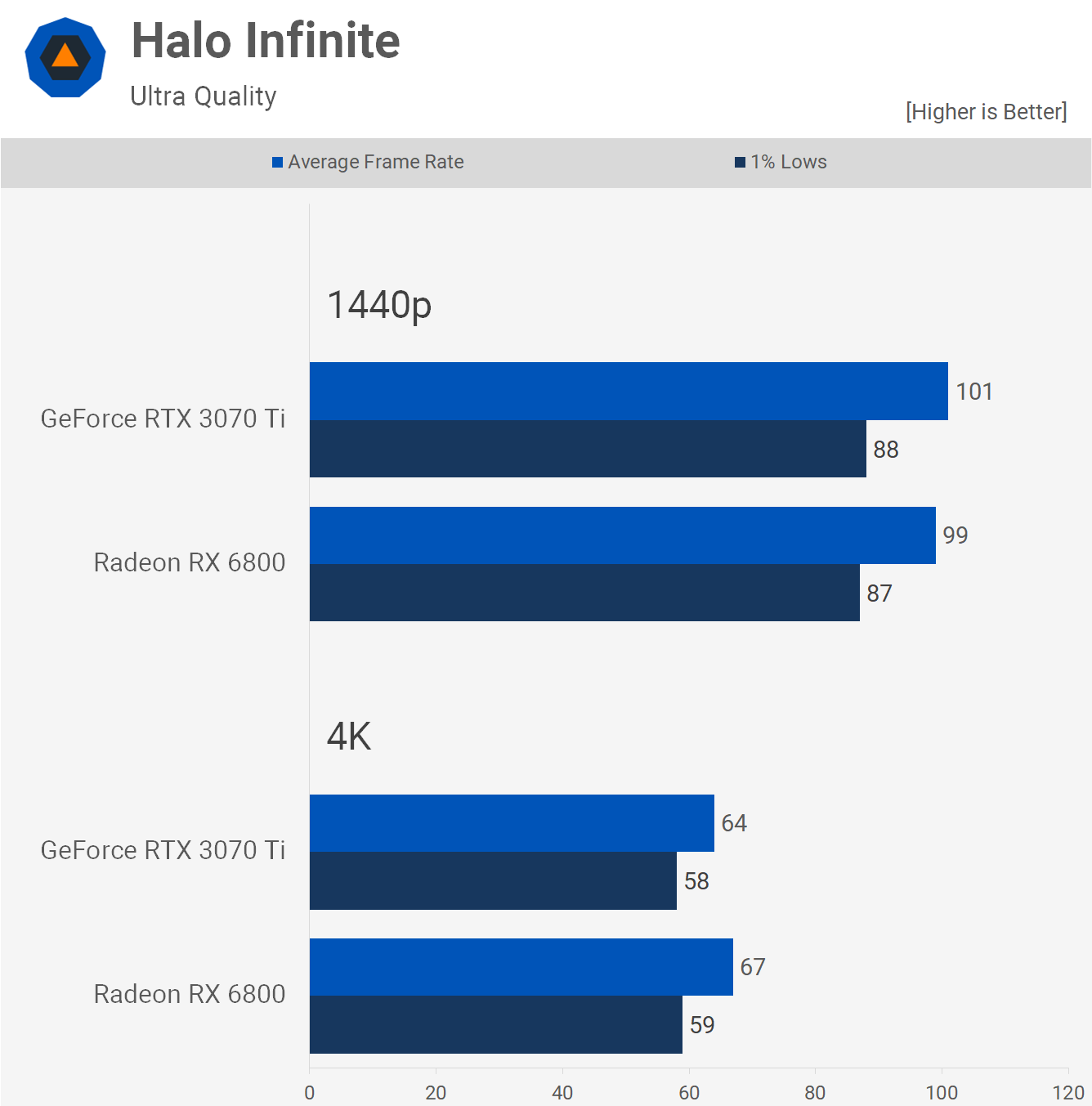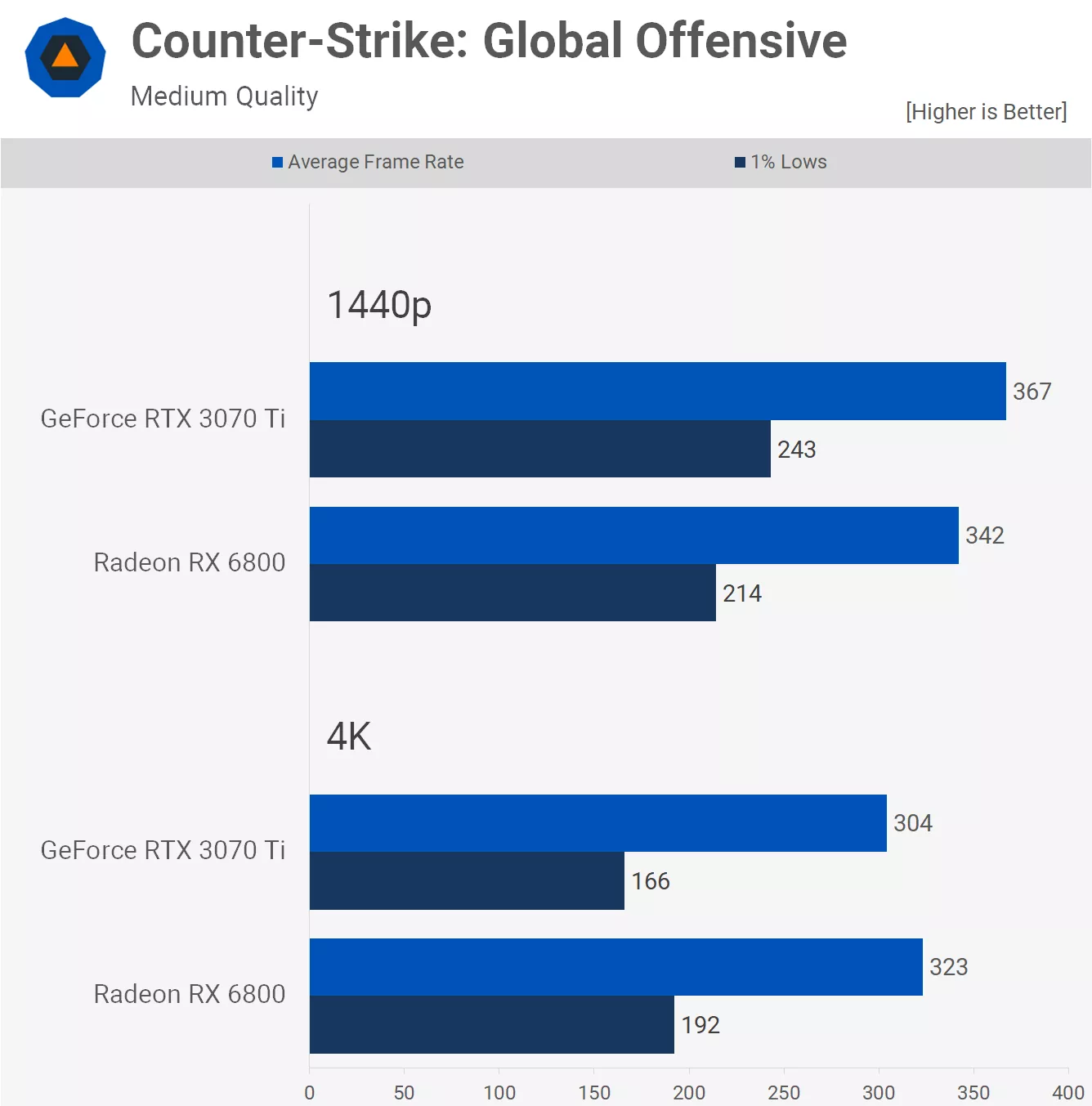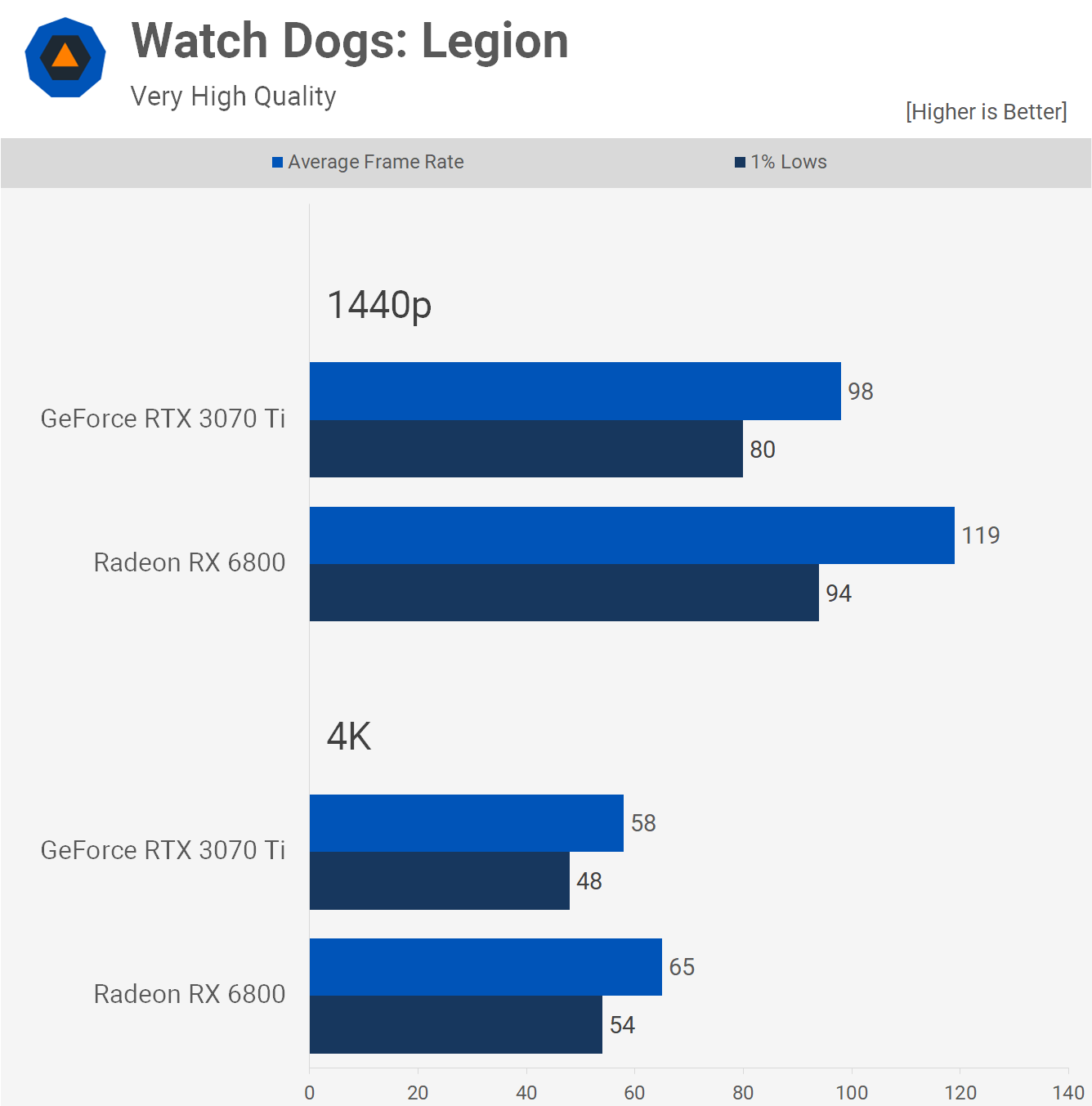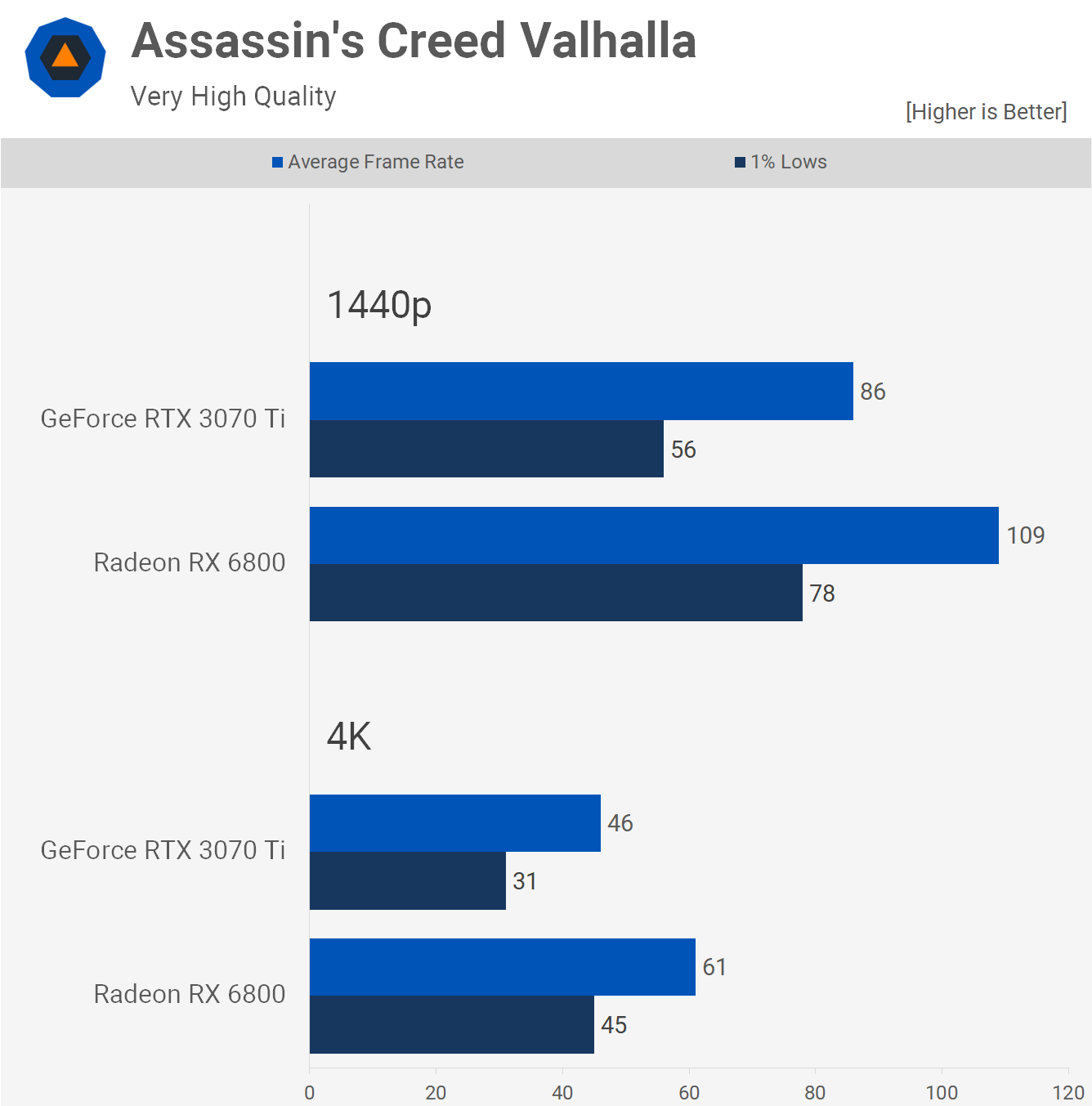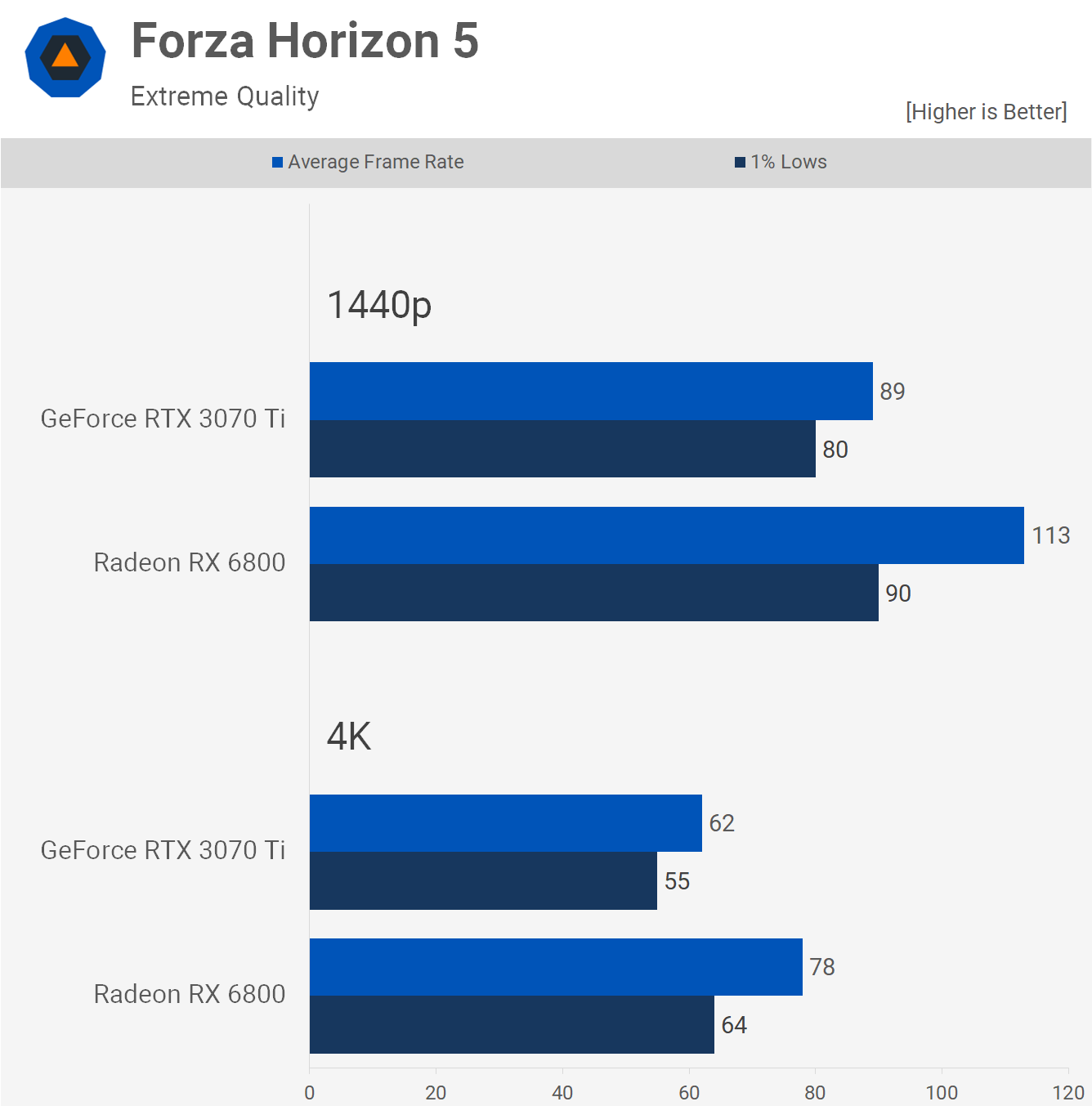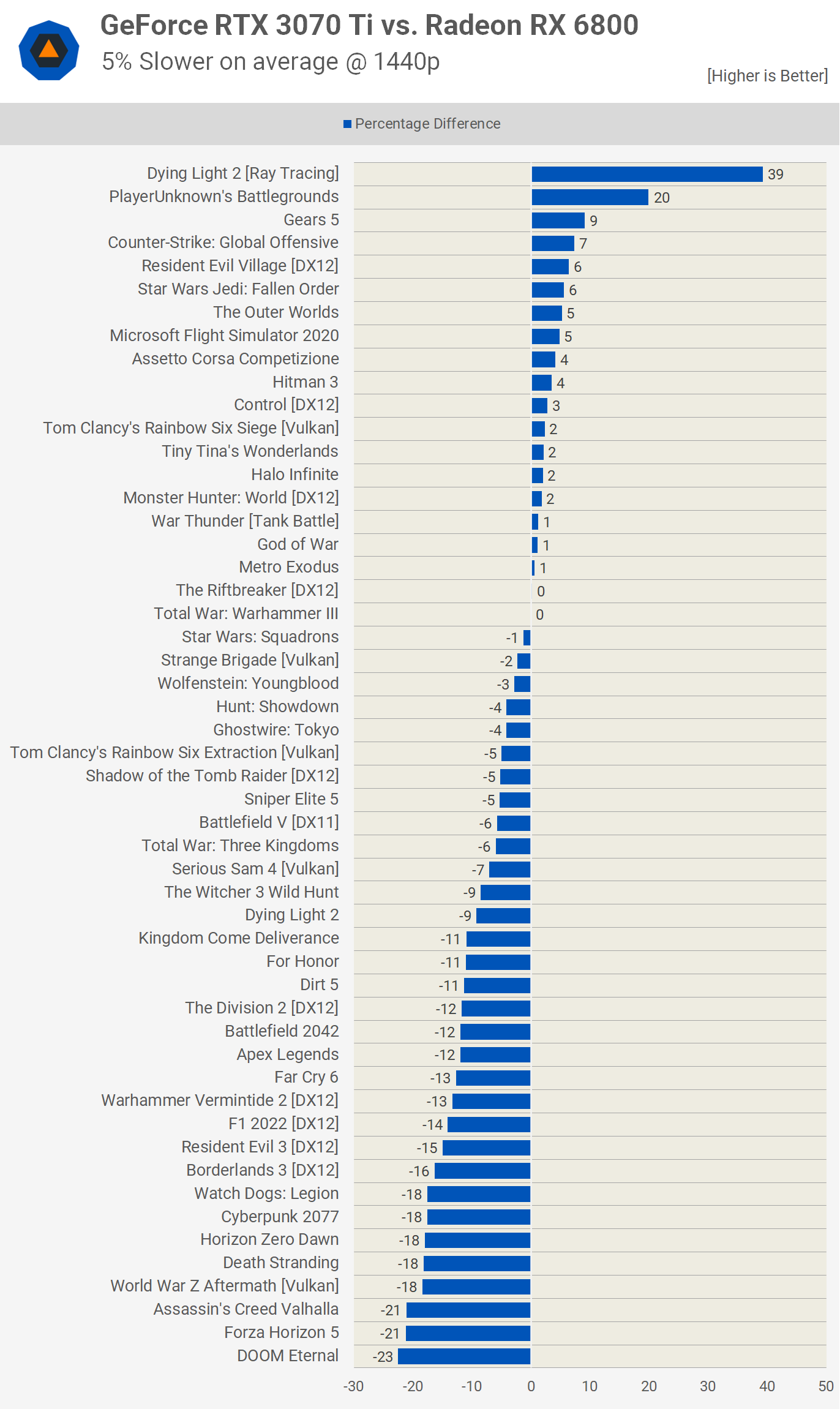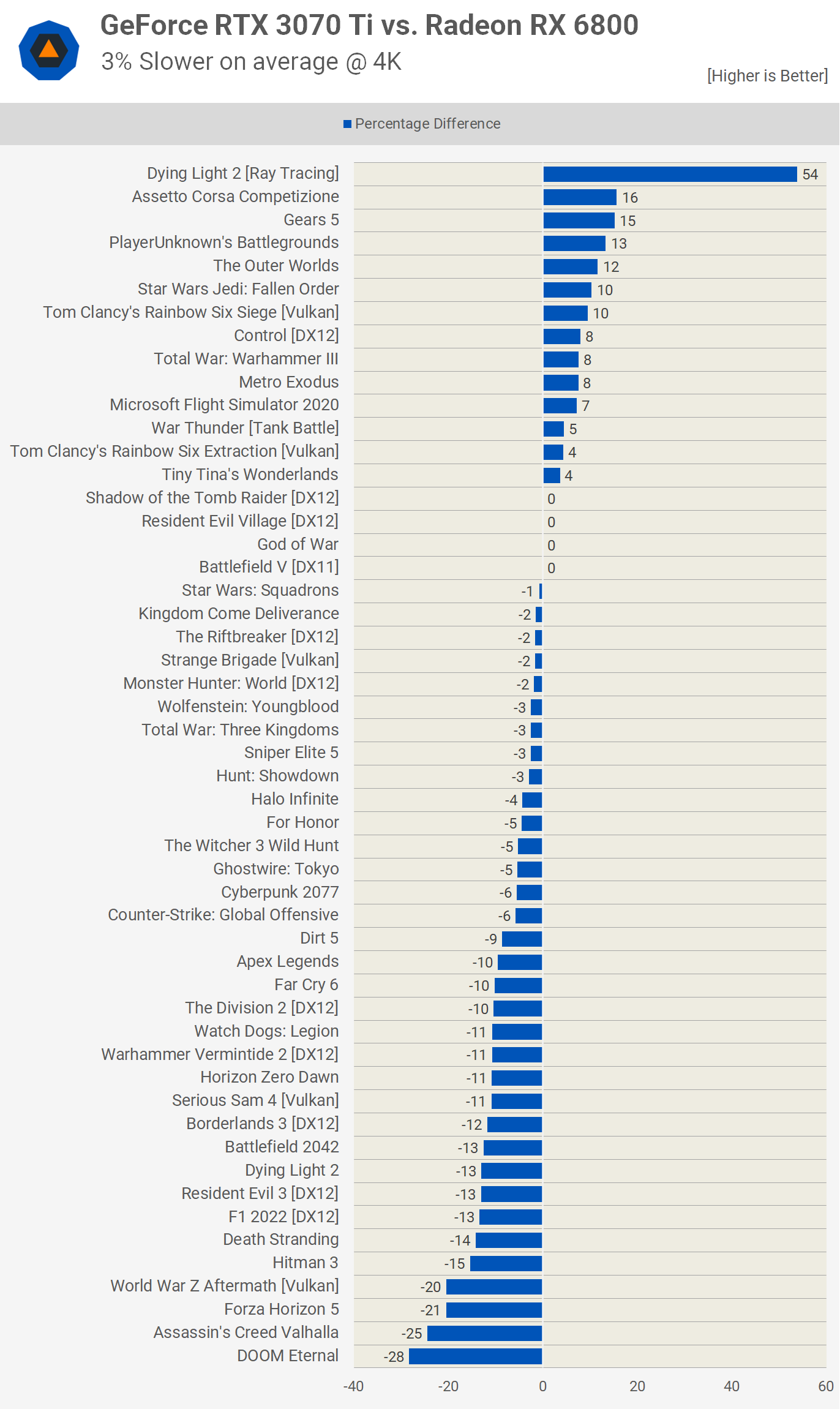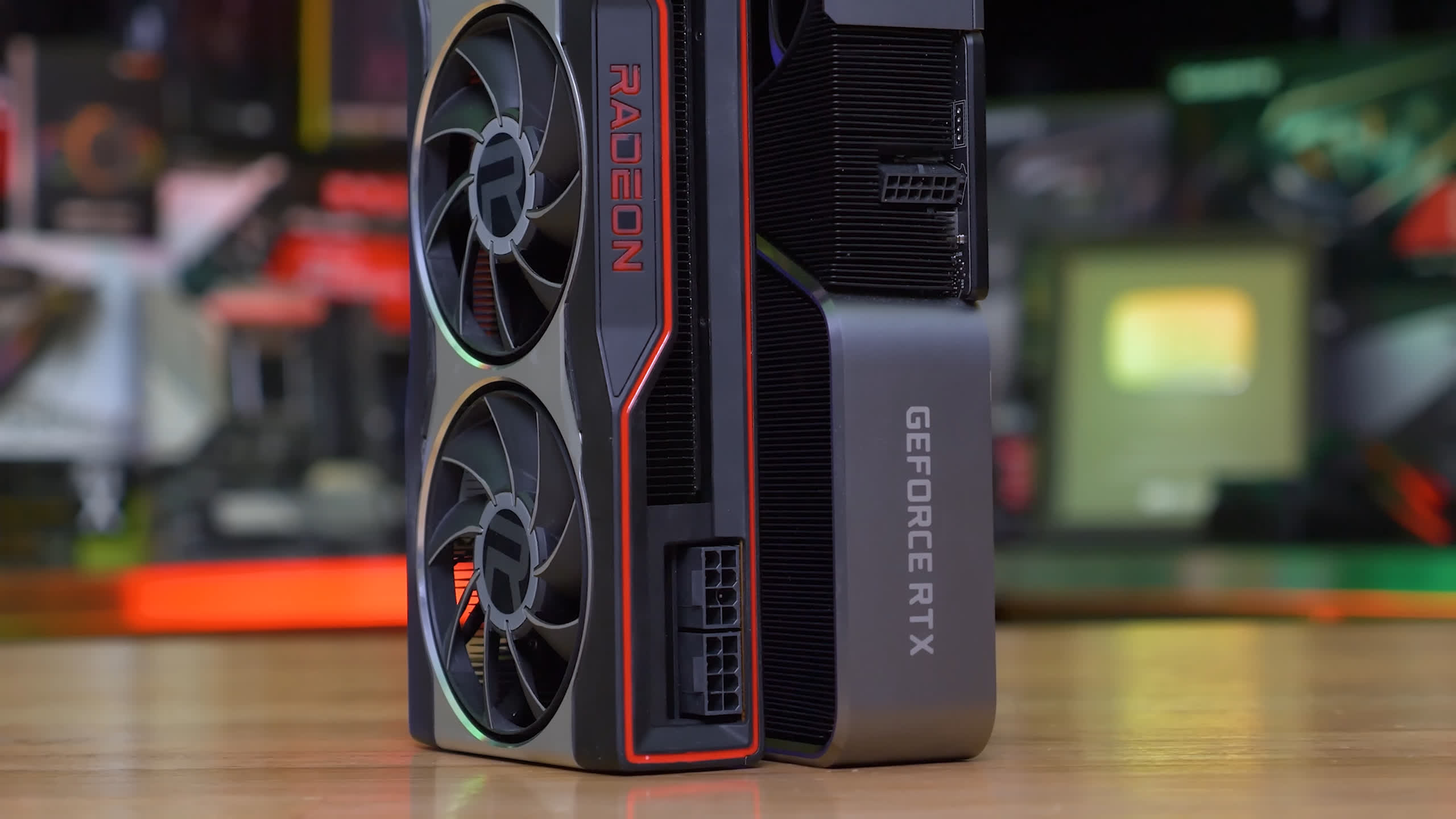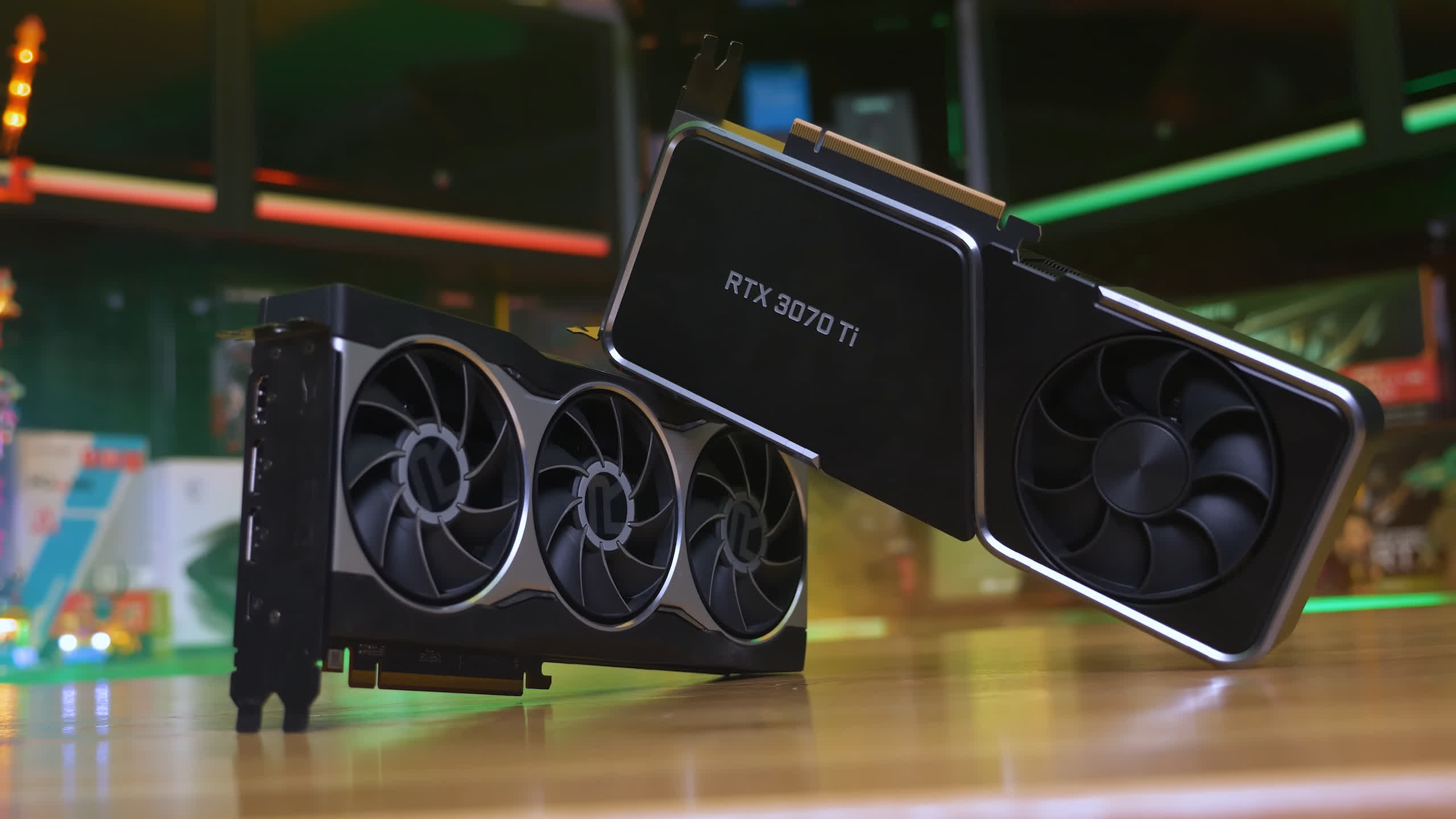Today we have a big GPU benchmark comparison for you, this time putting the GeForce RTX 3070 Ti against the Radeon RX 6800. As next-gen GPUs arrive and pricing returns to sane levels, we are left with "new" mainstream priced graphics cards that may be worthy of your consideration.
The Radeon RX 6800 looks to be well stocked these days and can be snapped up for just below the MSRP (currently fetching around $550). Same goes for the RTX 3070 Ti which is readily available at the moment, starting at $615. The RX 6800 wasn't a particularly popular product, though that was in large part due to availability issues which saw AMD focus on the 6800 XT and 6900 XT during the past few years of the crypto boom.
The first next-gen GPU to arrive is the GeForce RTX 4090, which we now know for a fact is much faster than any previous flagship, so for those seeking ultimate performance you're likely better off looking there as long as you can afford it. Meanwhile, as this and other RTX 40 series and Radeon 7000 series GPUs are announced, it's likely that prices of current gen GPUs, such as the RTX 3070 Ti and RX 6800, will tumble.
Also, with GPU mining declared dead, there's a good chance the used GPU market will eventually be flooded with GPUs, a perfect storm that should finally see gamers rewarded with cheaper graphics card options. Although we don't necessarily recommend you to buy either of these GPUs right now, we're interested to see how they compare in late 2022 on a range of new games, and of course, the latest display drivers.
As mentioned before, currently Radeon RX 6800 graphics cards can be had for as little as $540 with most models priced between $550 and $600. Given the MSRP is $580, it is possible to find some good models for less than that.
Then we have the GeForce RTX 3070 Ti which claims an MSRP of $600, but even today still sells for a little over that with the cheapest models listed at $630 though most range up towards $680.
There's a small price advantage for the Radeon, which isn't bad given it packs twice as much VRAM (16GB versus just 8GB for the 3070 Ti), that said, the 3070 Ti offers superior ray tracing capabilities and at present DLSS 2.0 is more broadly supported. So given those factors you might expect to pay less for the Radeon GPU.
In total we've tested a huge lot of 52 games at 1440p and 4K resolutions using the Ryzen 7 5800X3D and 32GB of dual-rank, dual-channel memory. Resizable BAR was enabled in the BIOS, and we used AMD Adrenalin Edition 22.8.2 and GeForce Game Ready 516.94 display drivers.
As usual we'll go over the data for about a dozen of the games tested to provide extra insight and then we'll take a look at all games in a single graph. Let's go for it.
Benchmarks
Starting with Assetto Corsa Competizione, we find very comparable results between these two GPUs at 1440p as the 3070 Ti was just 4% faster. However, bumping up the resolution to 4K handed the GeForce GPU an advantage, it was 16% faster hitting 133 fps on average compared to 115 fps for the Radeon 6800, a rather significant performance advantage...
The Outer Worlds isn't a great title for Radeon GPUs as it uses the Unreal Engine 4, but even so the Radeon RX 6800 is reasonably competitive and we'd say AMD's recent DX11 optimizations are helping.
As a result the RTX 3070 Ti was 5% faster at 1440p, but up to 12% faster at 4K and that saw it push up over 60 fps, hitting a 67 fps average.
Resident Evil Village has been benchmarked using the ray tracing preset and at 1440p this handed the RTX 3070 Ti a slim 6% win, though interestingly increasing the resolution to 4K neutralized the margins as both GPUs rendered 79 fps on average. This is one of the better ray tracing examples for AMD though, so let's look at a less favorable example.
This time with Dying Light 2 we've enabled the ray tracing preset and these are the results. Neither GPU is particularly impressive and even with an RTX 3070 Ti you'll want to drop down to 1080p with maybe a 60 fps experience.
Although the 3070 Ti was almost 40% faster at 1440p, it's a somewhat meaningless win. If you're happy gaming at 1080p and want to enjoy RT effects in this title, then the 3070 Ti is a must.
However, if you don't care for RT effects or believe the performance hit which halves frame rates isn't justified, then the Radeon 6800 does well in this title, offering 10% more performance than the 3070 Ti at 1440p and 15% more at 4K, with the high quality preset enabled. You're also looking at well over 80 fps at 1440p.
Sniper Elite 5 is a 2022 release that appears to run well on both AMD and Nvidia GPUs. At 1440p the RX 6800 was just 6% faster, while at 4K that margin was just 3%, or basically identical performance with both pushing over 70 fps.
That's a good level of performance given we're using the ultra quality preset.
God of War also plays nicely using either Ampere or RDNA2 GPUs as both the 3070 Ti and RX 6800 delivered the same level of performance at both tested resolutions. We're also looking at just shy of 60 fps at 4K using the ultra quality preset which enables a breathtaking gaming experience.
Here we have yet another newly released blockbuster title in Halo Infinite, where both GPUs delivered virtually identical performance. We're looking at ~60 fps at 4K using the ultra quality preset which looks great, and at least for the single player portion this is a satisfactory level of performance.
CS:GO is largely CPU bound though it's interesting to see the RTX 3070 Ti drop in performance by 17% when going from 1440p to 4K, while the RX 6800 saw a 6% decrease.
Either way performance was fairly comparable overall. The RTX 3070 Ti was a little faster at 1440p while the RX 6800 was a little faster at 4K.
Watch Dogs Legion is interesting as this is an Nvidia sponsored title and yet it plays much better on the Radeon 6800, even at 4K where 65 fps on average was possible.
The 1440p margin is huge, where the Radeon GPU was 21% faster pumping out an impressive 119 fps.
Assassin's Creed Valhalla has been tested using the second highest quality preset and with the aid of resizable bar, the RX 6800 is able to achieve 60 fps at 4K and push over 100 fps at 1440p.
This meant it was 27% faster than the RTX 3070 Ti at 1440p and 33% faster at 4K, so big wins here for the Radeon GPU.
Forza Horizon 5 also plays well with Radeon GPUs and benefits immensely from Resizable BAR support. As a result, the RX 6800 was 27% faster at 1440p and 26% faster at 4K.
Performance Summary
Based on the dozen or so games we just looked at, the RTX 3070 Ti and RX 6800 appear to be very close in terms of performance. There were a few titles that did heavily favor one over the other, but for the most part performance appeared very similar.
We did spend a week testing through just over 50 games, so let's go check out that data...
Compared to our benchmark data from the day-one review, the RTX 3070 Ti was 8% slower than the RX 6800 at 1440p, though that was only a dozen game sample. A little over a year later with 50+ games we find that on average the 3070 Ti is just 5% slower.
If we wanted to remove the RT-enabled Dying Light 2 score which can be considered an outlier, that margin changes by a percent to 6%, which is not a big deal in the grand scheme of things.
Jumping up to 4K reduces the margin further and now the RTX 3070 Ti is just 3% slower on average, either way performance is very similar overall.
It's interesting to note that the games where the RTX 3070 Ti does well relative to the Radeon 6800 are predominantly based on the Unreal Engine 4 such as ACC, Gears 5, PUBG, The Outer Worlds and Star Wars Jedi Fallen Order as prime examples.
Meanwhile, the Radeon RX 6800 excels in games such as Doom, which uses the id Tech 7 game engine, Assassin's Creed Valhalla which uses AnvilNext 2.0, Forza Horizon 5 using the ForzaTech engine, World War Z using the Swarm Engine, Hitman 3 using the Glacier 2 engine, and F1 22 using the Ego engine. Not a single Unreal Engine game to speak of.
Picking a Winner
The last time we compared the Radeon RX 6800, it was against the original RTX 3070 (the non-Ti model). We found the Radeon was priced too closely to the RTX 3070 and it had weaker ray tracing performance. DLSS was also a key selling point for the GeForce, especially because FSR had yet to be unveiled.
Even though the Radeon does have twice as much VRAM, there are few examples we could cite where this actually makes a difference. Even today the RTX 3070 Ti seems to get by pretty well with just 8GB of VRAM, but there are more instances where performance takes a hit, especially with RT effects enabled.
As it stands right now, an RTX 3070 Ti graphics card will cost you at least 15% more and outside of ray tracing, there are almost no games where it's 15% faster than the RX 6800. Still, if we go by the average performance, the RTX 3070 Ti is about 5% slower, so you're certainly paying a premium for the GeForce GPU.
DLSS remains superior to FSR, particularly in terms of game support even though it's improving on AMD's side. In many instances they're very close in terms of image quality that most gamers won't notice the difference (DLSS 2.0 vs FSR 2.0). So DLSS is a bigger key selling point of RTX graphics cards as long as the games you play are supported but not with FSR, otherwise they are now on a more even level since we last compared them.
The big win for Nvidia is the superior ray tracing performance and the big win for AMD is the massive VRAM buffer at 16GB. We think that with pricing relatively close and rasterization performance fairly similar across a large sample of games, it will come down to what you prefer: a big memory buffer or better RT support.
Update (10/17): At the time of publishing this comparison, some readers have pointed out that beyond the Radeon RX 6800 tested here, there seems to be a sudden new decrease in pricing for faster 6800 XT (lowest priced at $539 on Newegg) and even 6900 XT GPUs (lowest model found at $669 on Amazon), making them ever more attractive if you're buying in this price range.
If the Radeon GPU was 20% cheaper it would become the obvious choice for most, but again, if you want that ray tracing performance or DLSS game support, then paying a hefty premium might be worth it. Likewise, if the GeForce GPU was 10-15% cheaper then we think it would be the obvious choice for most gamers.
